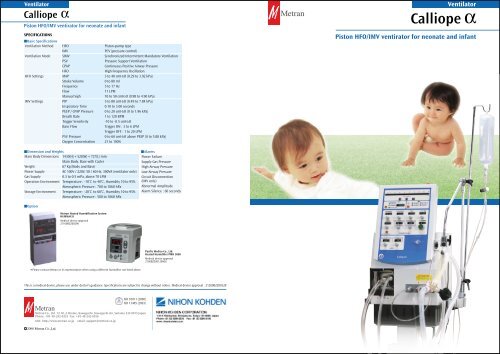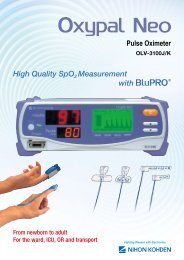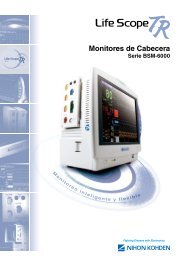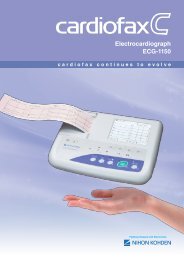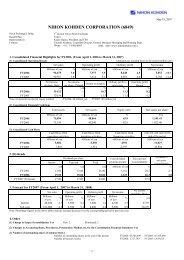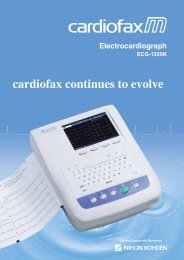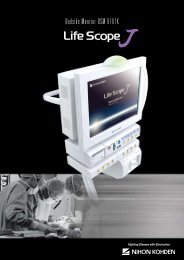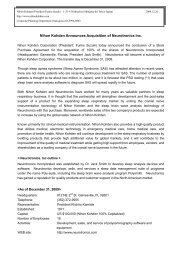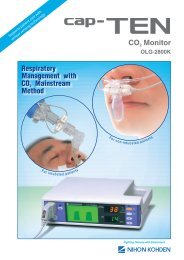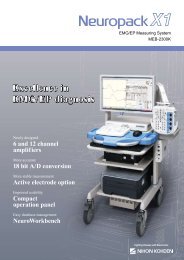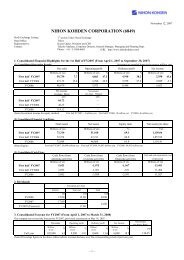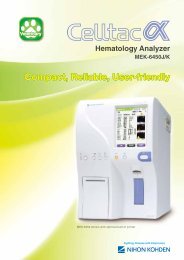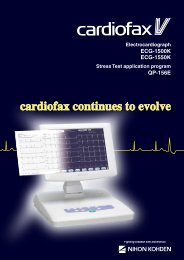Calliope α ventilator - Nihon Kohden
Calliope α ventilator - Nihon Kohden
Calliope α ventilator - Nihon Kohden
Create successful ePaper yourself
Turn your PDF publications into a flip-book with our unique Google optimized e-Paper software.
Ventilator<br />
<strong>Calliope</strong> <strong>α</strong><br />
Piston HFO/IMV ventirator for neonate and infant<br />
SPECIFICATIONS<br />
Basic Specifications<br />
Ventilation Method<br />
Ventilation Mode<br />
HFO Settings<br />
IMV Settings<br />
HFO<br />
IMV<br />
SIMV<br />
PSV<br />
CPAP<br />
HFO<br />
MAP<br />
Stroke Volume<br />
Frequency<br />
Flow<br />
Manual Sigh<br />
PIP<br />
Inspiratory Time<br />
PEEP / CPAP Pressure<br />
Breath Rate<br />
Trigger Sensitivity<br />
Base Flow<br />
PSV Pressure<br />
Oxygen Concentration<br />
Piston-pump type<br />
PCV (pressure control)<br />
Synchronized Intermittent Mandatory Ventilation<br />
Pressure Support Ventilation<br />
Continuous Positive Airway Pressure<br />
High Frequency Oscillation<br />
3 to 40 cmH2O (0.29 to 3.92 kPa)<br />
0 to 80 ml<br />
5 to 17 Hz<br />
11 LPM<br />
10 to 50 cmH2O (0.98 to 4.90 kPa)<br />
5 to 80 cmH2O (0.49 to 7.84 kPa)<br />
0.10 to 3.00 seconds<br />
0 to 20 cmH2O (0 to 1.96 kPa)<br />
1 to 120 BPM<br />
-10 to -0.5 cmH2O<br />
Trigger ON : 3 to 6 LPM<br />
Trigger OFF : 1 to 20 LPM<br />
0 to 60 cmH2O above PEEP (0 to 5.88 kPa)<br />
21 to 100%<br />
Metran<br />
Ventilator<br />
<strong>Calliope</strong> <strong>α</strong><br />
Piston HFO/IMV ventirator for neonate and infant<br />
Dimension and Weights<br />
Main Body Dimensions<br />
Weight<br />
Power Supply<br />
Gas Supply<br />
Operation Environment<br />
Storage Environment<br />
1430(H) * 520(W) * 727(L) mm<br />
Main Body, Base with Caster<br />
67 Kg (Body and Base)<br />
AC 100V / 220V, 50 / 60 Hz, 300VA (<strong>ventilator</strong> only)<br />
0.3 to 0.5 mPa, above 70 LPM<br />
Temperature : -10; to 40;, Humidity 10 to 95%<br />
Atmospheric Pressure : 700 to 1060 hPa<br />
Temperature : -20; to 60;, Humidity 10 to 95%<br />
Atmospheric Pressure : 500 to 1060 hPa<br />
Alarms<br />
Power Failure<br />
Supply Gas Pressure<br />
High Airway Pressure<br />
Low Airway Pressure<br />
Circuit Disconnection<br />
(IMV only)<br />
Abnormal Amplitude<br />
Alarm Silence : 60 seconds<br />
Option<br />
Metran Heated Humidification System<br />
HUMMAX II<br />
Medical device approval<br />
21100BZZ00290<br />
Pacific Medico Co., Ltd.<br />
Heated Humidifier PMH 5000<br />
Medical device approval<br />
2100BZZ00120000<br />
Please contact Metran or its representative when using a different humidifier not listed above.<br />
This is a medical device, please use under doctor's guidance. Specifications are subject to change without notice. Medical device approval : 21200BZZ00328<br />
ISO 9001 (2000)<br />
ISO 13485 (2003)<br />
Metran<br />
Metran Co., Ltd. 12-18, 2-Chome, Kawaguchi, Kawaguchi-shi, Saitama 332-0015 Japan<br />
Phone: +81-48-242-0333 Fax: +81-48-242-0550<br />
URL: http://www.metran.co.jpemail: support@metran.co.jp
Ventilator<br />
More subtle & more dynamic<br />
Feel and experience the new <strong>Calliope</strong> <strong>α</strong><br />
Newly-evolved HFOV<br />
Enhanced MAP (mean airway pressure),<br />
now configurable up to 40cmH2O<br />
For a better respiratory care management,<br />
stroke volume is now adjustable in units of 0.2ml<br />
Frequency is now adjustable between 5 to 17Hz<br />
for more accurate control<br />
Reliable respiration management<br />
using HFOV (or HFO mode) is possible<br />
only with the combination<br />
of "stroke volume", "MAP" and<br />
"frequency" parameters.<br />
Setting of frequency is available<br />
from 5 Hz to 17 Hz.<br />
* Heated Humidifier is an option.<br />
Piston HFO<br />
Pressure oscillation<br />
generated by reciprocal<br />
movement of<br />
<strong>Calliope</strong> <strong>α</strong> piston<br />
makes pressure<br />
wave sinusoidal,<br />
applying less strain<br />
on patient's lungs.<br />
Push-pull piston-type HFO reduces the<br />
likelihood of air trapping since inspiratory<br />
and expiratory volumes are identical<br />
(I:E ratio= 1:1).<br />
Magnet-joint horizontal design allows<br />
enhanced reduction of the noise, and<br />
offers quiet operation and also improves<br />
serviceability.<br />
Simple piston removal provides easy<br />
and convenient cleaning and sterilization.<br />
Accurate HFO Settings<br />
Stroke volume is now adjustable in<br />
units of 0.2ml, to make the amplitude<br />
management (airway pressure amplitude)<br />
more precise.<br />
PaO2 and PCO2 are independently controlled<br />
by value of mean airway pressure<br />
and stroke volume respectively.<br />
Manual SIGH<br />
(Lung Recruitment Manoeuvre)<br />
Original inspiratory<br />
and expiratory valves<br />
Metran's original Inspiratory and Expiratory<br />
valves offer high-speed and accurate<br />
flow control required in PSV, providing<br />
instant response for patient's<br />
spontaneous breathing, and allowing<br />
smooth switch-over between inspiration<br />
and expiration.<br />
Safety Design<br />
Setting Verification<br />
An alarm activates every time a setting<br />
on the front panel has been changed.<br />
This safety feature ensures to alert the<br />
operator when any accidental change<br />
in setting occurs.<br />
Impedance Valve<br />
Impedance valve controls the inspiratory<br />
gas flow in both HFO and IMV<br />
modes. This allows our system to work<br />
with water-chamber type heated humidifiers<br />
as well as with our proprietary<br />
humidifier.<br />
* High inpedance Valve and<br />
typical installation example.<br />
Ventilator Gas Flow<br />
CMV<br />
MAP<br />
MAP<br />
MAP<br />
MAP : Mean Airway Pressure<br />
HFO<br />
Comparison of<br />
CMV and HFO pressure wave form<br />
This figure compares CMV and HFO pressure<br />
wave forms at the same mean airway<br />
pressure (MAP). The HFO pressure waves are<br />
sinusoidal and symmetrical with respect to<br />
the MAP axis. Upon entering the trachea<br />
after passing through the endotracheal tube,<br />
the amplitude of sinusoidal wave is<br />
attenuated drastically at the periphery of<br />
the airways near the pulmonary alveoli.<br />
Thus, at a given MAP, HFO can be expected<br />
to cause much less physical damage to<br />
pulmonary alveoli than would be the case<br />
with CMV.<br />
Breathing modes can be changed<br />
by just turning one knob.<br />
Sigh pressure for shorter and safer lung<br />
recruitment.<br />
Sigh pressure is independently adjusted<br />
from the operating MAP and others settings<br />
and is activated by just holding<br />
pressed the "Manual Breath" button.<br />
PCV & PSV Features<br />
Pressure controlled ventilation (PCV) in<br />
IMV, supported by pressure support<br />
ventilation (PSV), for patient's spontaneous<br />
breathing management.<br />
Synchronization to patient's spontaneous<br />
breathing reduces respiratory muscular<br />
stress, not only for assisted ventilation<br />
purpose but also for weaning<br />
support of the patients.<br />
Electrical FiO2 Blender<br />
Inspiratory gas oxygen concentration<br />
controlled by stepping motor and heat<br />
flow sensor, has been newly implemented.<br />
It is adjusted without a use of<br />
exhaust blow, eliminating unnecessary<br />
gas usage.


